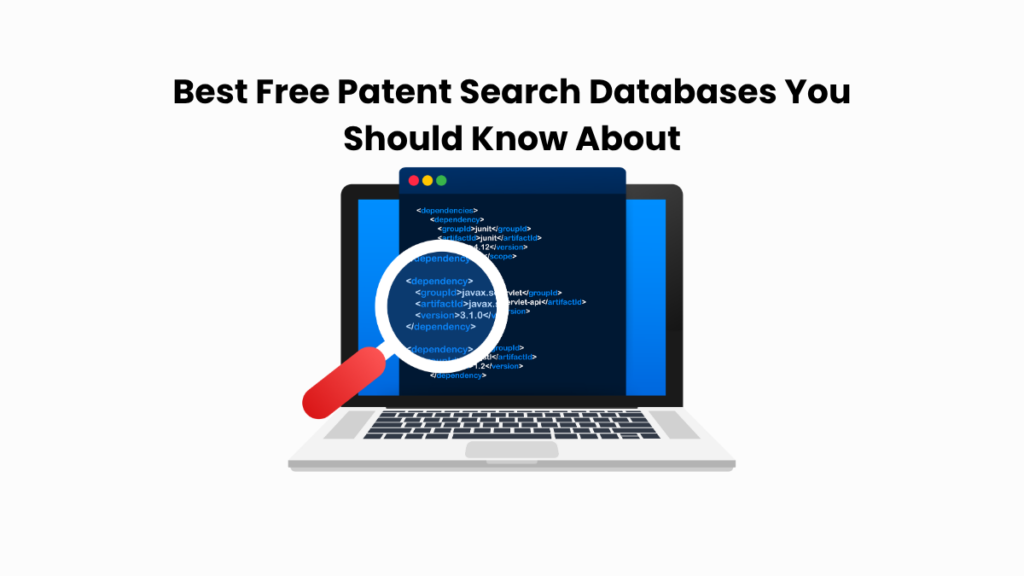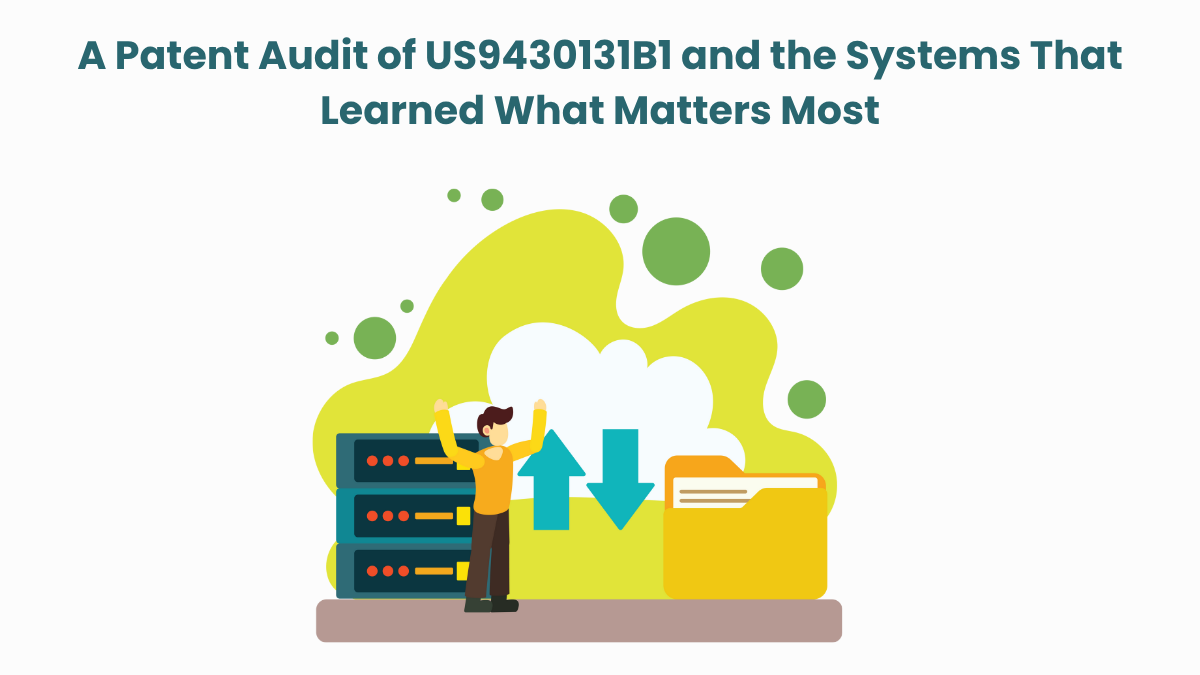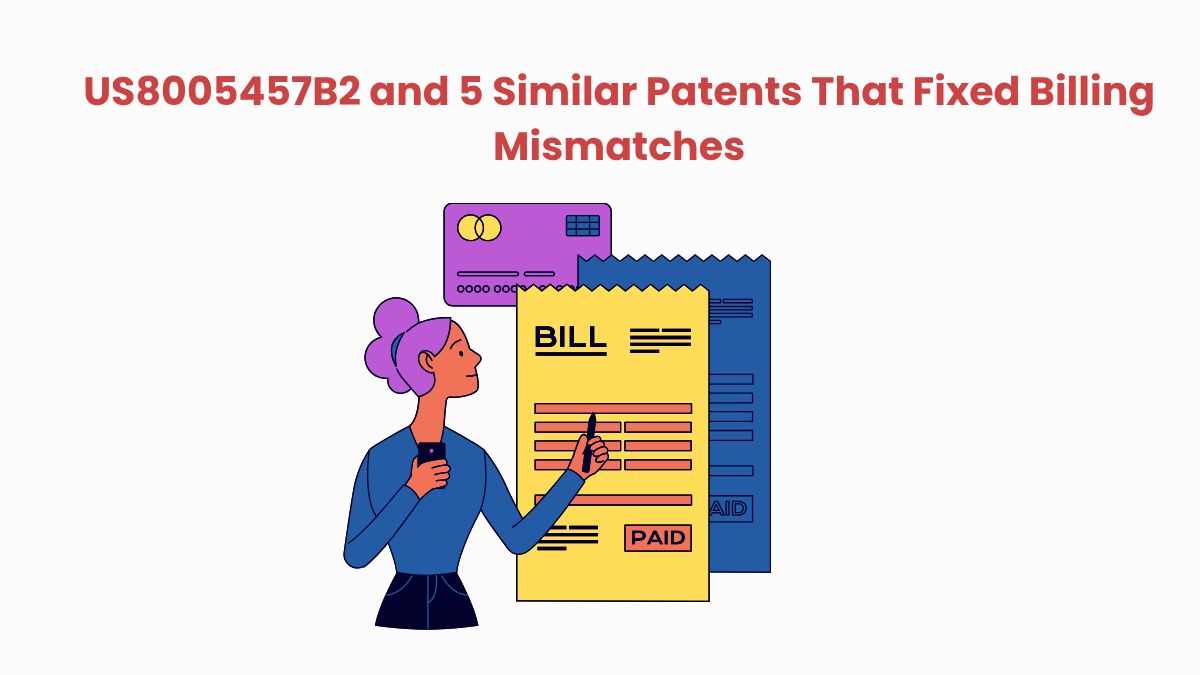Looking for patents sounds simple enough, but once you actually start, the first challenge isn’t the search itself, it’s knowing where to search. The internet is full of free patent databases, yet they’re not all built the same.
Some let you type in your idea in plain English, while others expect you to craft complex Boolean queries. A few focus on specific regions or industries, while others pull in data from patent offices across the world.
And now, with AI-powered tools entering the mix, searching has become faster and smarter, but not always free. If you’re just exploring one or two ideas, paying for a massive database rarely makes sense.
That’s why we’ve curated this list of the Top Patent Search Databases that help you find the right fit for your needs, and doesn’t hurt your pockets much.
Let’s take a look at what each platform offers and how it can make your patent search easier and more efficient.
#1. Global Patent Search
Global Patent Search(GPS) is built to make patent research effortless. It was created to transform how innovators explore ideas. Most patent search tools make you dig through endless results. GPS makes the process effortless, insightful, and fast.
It all started with a simple realization. There was no single platform that connected historical patent data with modern innovation trends. So the creators of GPS built a search engine that does more than just find documents. It helps you truly understand them.
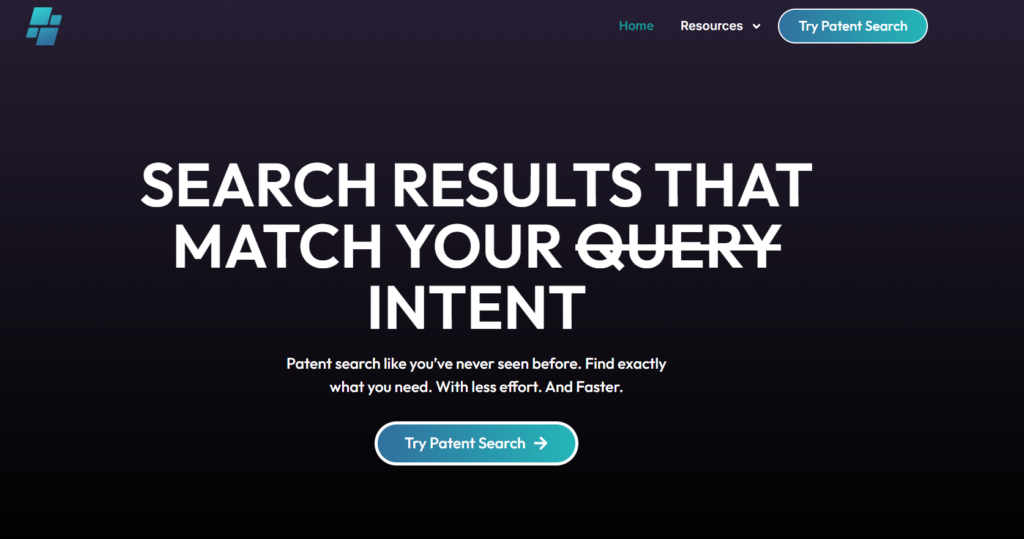
Source – GPS
Instead of spending hours scrolling through complex databases or crafting keyword-heavy queries, you can simply describe your idea in plain English, and the tool instantly finds patents that match your concept. It’s powered by advanced AI that understands technical language, compares features across inventions, and highlights connections that traditional searches often miss.
What makes GPS stand out is its ability to go beyond just search results. It reads patents like an expert analyst: analyzing claims, identifying similar technologies, and mapping relationships across multiple inventions.
Whether you’re testing the novelty of an idea, studying competitors, or checking for prior art, GPS helps you find answers faster and more accurately.
Key Features
- AI-Powered Patent Discovery: Type your idea in plain language, and GPS AI instantly identifies patents and NPL that match your concept. Not just that, it also lets you find relevant prior art simply by adding patent number in the search bar. Experts can also perform a full keyword-based seach too.
- Relevant Excerpts: View relevant snippets between patents, including which features are fully or partially disclosed in related inventions.
- Comprehensive Global Coverage: Access patent data from major authorities like the USPTO, EPO, WIPO, CNIPA, and 60 other patent offices, and non patent literature all in one interface.
- Automated Reports and Collaboration: You can sort by filters, save searches, and share findings with your team in one click.
All in all, it’s an amazing tool for users irrespective of their experience with patent searches. You can request access to the GPS tool here.
#2. Google Patents
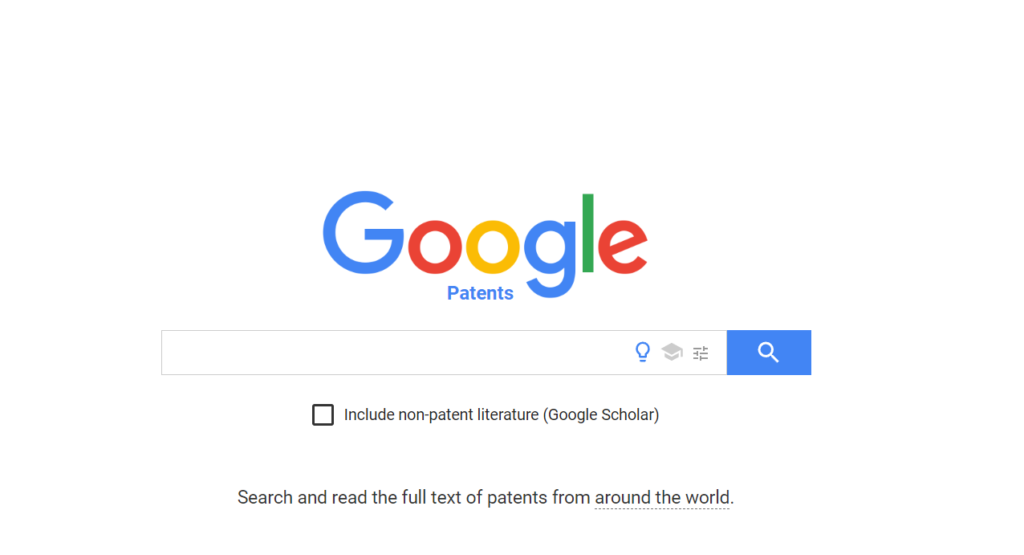
Source: Google Patents
Google Patents is a free search engine that allows you to explore over 120 million patents from more than 100 patent offices worldwide. It’s great for anyone diving into patent research because you can read the entire content of patents, not just summaries.
Plus, it’s designed to make your search quick and simple, showing all the details, like images and legal information on one page.
Key Features
- Extensive Database: Offers access to patents from major patent offices worldwide, including the USPTO, EPO, and CNIPA.
- Advanced Search: Utilizes Boolean syntax and allows filters by date, inventor, and assignee for precise search results.
- Multilingual Translations: Features superior translation capabilities, especially for Chinese patents, enhancing accessibility for global users.
- Integration with Scholarly Resources: Links with Google Scholar and Google Books to provide a broader context and supporting patented/non-patented documents.
- User-Friendly Interface: Allows side-by-side patent viewing and easy saving of patents as PDFs, coupled with a secure, encrypted browsing environment.
#3. Espacenet Patent Search
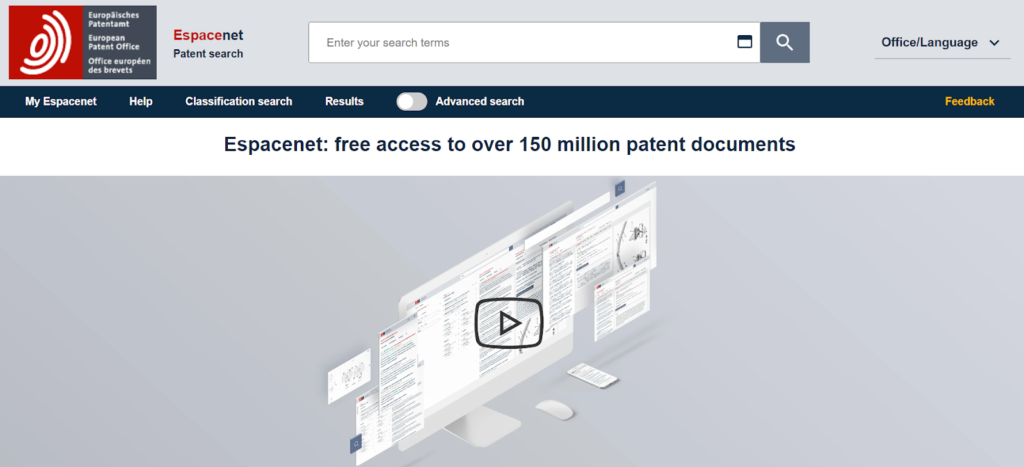
Source: Espacenet
Espacenet is one of the free patent search databases created by the European Patent Office (EPO) in collaboration with European Patent Organisation member states in 1998. It was designed to make it easy for anyone to access patent information worldwide.
Espacenet offers access to over 120 million patents from 100+ patent offices, providing a rich resource for exploring inventions globally. Espacenet is especially praised for its ability to translate complex technical terms between English and various other languages including including Arabic and Chinese.
Key Features
- Wide-Ranging Access: Browse a huge collection of patents from 97 countries, helping you explore various inventions and ideas.
- Flexible Search Options: Use the Smart Search for quick keyword searches, Advanced Search for more specific details like the invention’s title or the inventor’s name, and Classification Search to look into specific types of technology.
- Expert Translations: Features a powerful translation tool that’s great for reading patents in different languages, using translations based on millions of official documents.
- Helpful Search Extras: Includes a feature to view all related documents and references for a patent in one place, which is great for checking how unique an idea is.
- Easy to Use: Works well on phones, tablets, and computers. You can also save your searches, download patents for offline reading, and keep track of your search history.
We’ve also shared the 10 best patent analysis tools available in 2024 to help you effectively evaluate and manage your IP.
#4. USPTO Web Patent Database
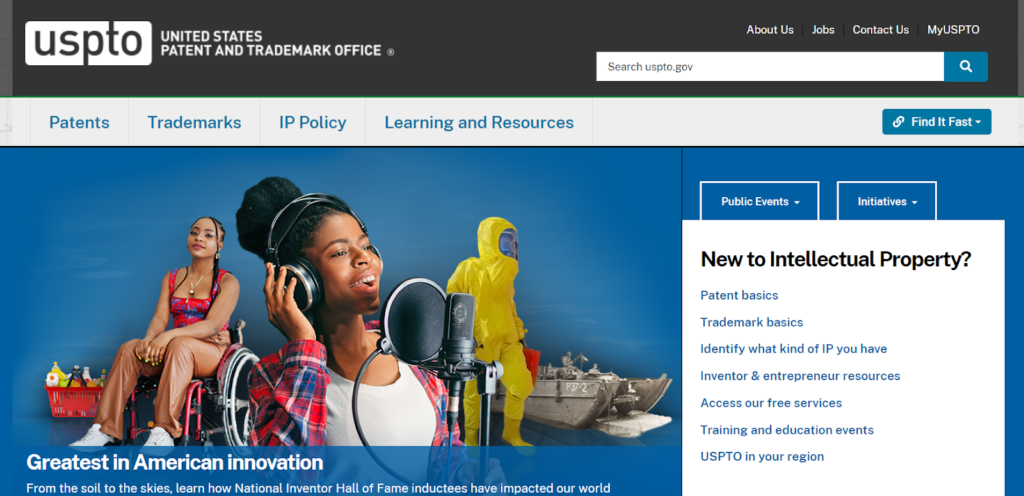
Source: USPTO
The United States Patent and Trademark Office (USPTO), part of the U.S. Department of Commerce, is the go-to place for all things patents and trademarks in the U.S. It provides a comprehensive database where you can explore not only granted patents but also applications that are still in process.
The website is a treasure trove of resources, offering everything from basic information about patents and trademarks to detailed guides on the application processes and maintenance.
Although the interface is quite basic, it delivers precise and current legal status and comprehensive details for each patent.
Key Features
- “Find It Fast” Option: Access detailed information quickly on both pending and approved inventions and trademarks.
- Global Dossier: Connect easily to documents and applications from international patent offices.
- Public Search Facility: Receive personal help and free access to comprehensive information on patents and trademarks.
- Patent and Trademark Resource Centers (PTRCs): Find local centers for in-depth assistance and learning about inventions and trademarks.
- Official Gazette: Browse through the latest approved inventions, organized categorically for quick viewing.
- Common Citation Document (CCD): Explore detailed connections between various inventions to assess their uniqueness.
- Patent Examination Data System (PEDS): Search, view, and download detailed data on publicly available inventions.
#5. PQAI
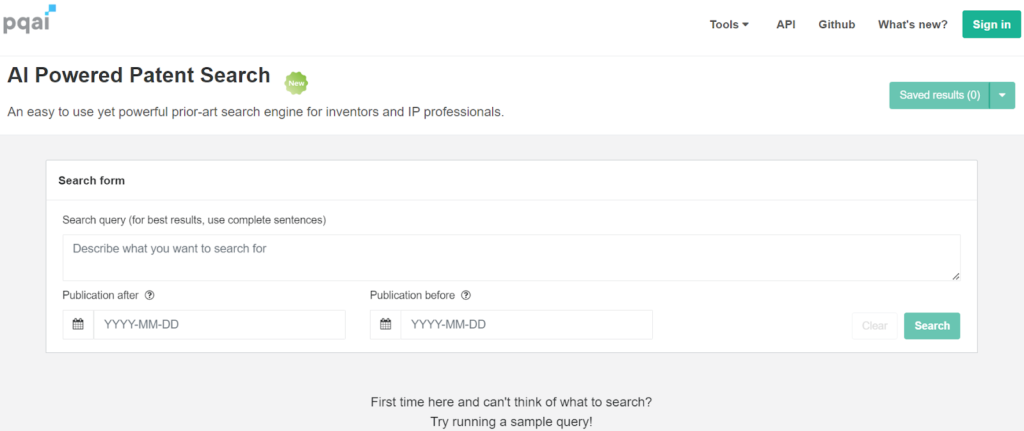
Source: PQAI
PQAI, supported by AT&T and the Georgia Intellectual Property Alliance, is an open-source, free patent search database revolutionizing patent searches.
By leveraging AI and natural language processing, PQAI simplifies the search process, allowing inventors to describe their inventions in everyday language. This approach quickly delivers the top 20 most relevant results, with options to delve deeper.
The platform stands out for its user-friendly design devoid of complicated legal jargon and prioritizes confidentiality by not storing search data unless specifically requested.
Key Features
- AI-Powered Search Engine: Quickly identifies the most relevant invention references using AI, simplifying novelty assessment and idea validation.
- AI-Driven CPC Lookup: Automatically suggests precise classification codes based on your invention description, enhancing search efficiency.
- Group Art Unit Predictor: Predicts the likely USPTO art units for your patent application, aiding in strategic preparation.
- Concept Extractor: Extract essential concepts from your input, refining search terms to increase result accuracy.
- Keyword Suggester: Provides tailored keywords to deepen and broaden patent research.
- Sample Queries: Offers example searches to demonstrate the platform’s functionality and assist users in mastering the search tool.
#6. PATENTSCOPE
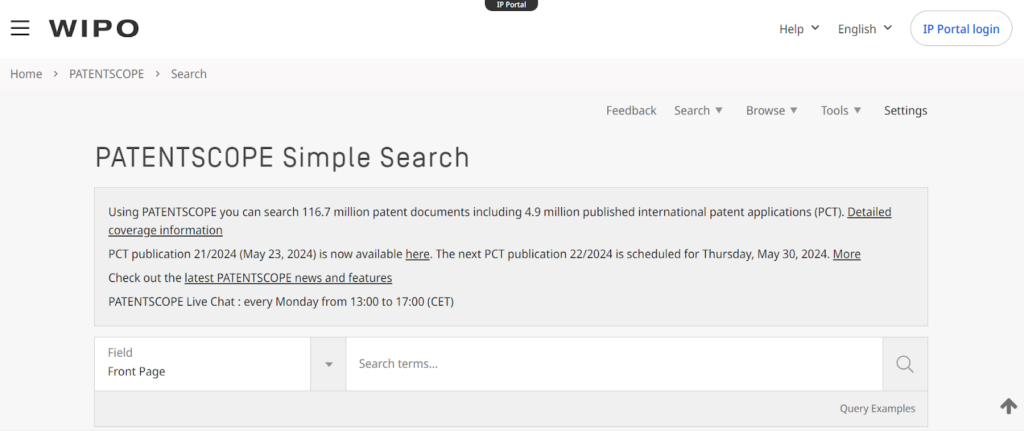
Source: PATENTSCOPE
PATENTSCOPE, managed by the World Intellectual Property Organization (WIPO), provides comprehensive and free access to over 117 million patent documents, including 4.9 million published international patent applications (PCT). Launched in 2001, this extensive database not only includes major collections from global patent offices such as the USPTO and China but also keeps up-to-date with the latest publications and developments.
With its interface available in multiple languages, including Arabic, Chinese, English, French, and more, PATENTSCOPE is an invaluable resource for a diverse global audience.
Key Features
- Diverse Search Tools: Includes Simple Search for quick queries, Advanced Search for detailed filtering, Field Combination Search for customized criteria, Cross-Lingual Search for multi-language navigation, and Chemical Compounds Search for specialized queries.
- Regular Updates: Keeps users informed of the latest patent publications, including upcoming releases and developments.
- Live Chat Support: Delivers real-time assistance every Monday from 13:00 to 17:00 CET to help users navigate the platform.
- Alerts and Monitoring: Allows users to set up alerts and RSS feeds to track new publications and monitor specific areas of interest.
#7. WIPO INSPIRE

Source: WIPO INSPIRE
Launched in November 2020, WIPO INSPIRE is a tool that helps innovators and entrepreneurs find the right tools for searching patents. It makes it easier for anyone interested in patents, whether you’re just starting or a seasoned professional, to get the information they need quickly and efficiently. It’s like a guide that helps you navigate through the world of patents and innovation.
Key Features
- Database Selection Made Easy: Guides you through choosing the best patent search database tailored to your specific needs, ensuring you find relevant patent information effortlessly.
- Streamlined Patent Searches: Simplifies the process of searching for patent information, whether you’re checking the novelty of an invention or keeping an eye on competitors.
- Accessible Insights and Analytics: Provides clear, easy-to-understand reports and analyses on patents across various technologies and industries, helping you spot trends and make informed decisions.
- Enhanced Tools and Resources: Offers a wealth of additional support, including expert connections and educational materials, to help manage and advance your innovation efforts.
#8. Lens.org
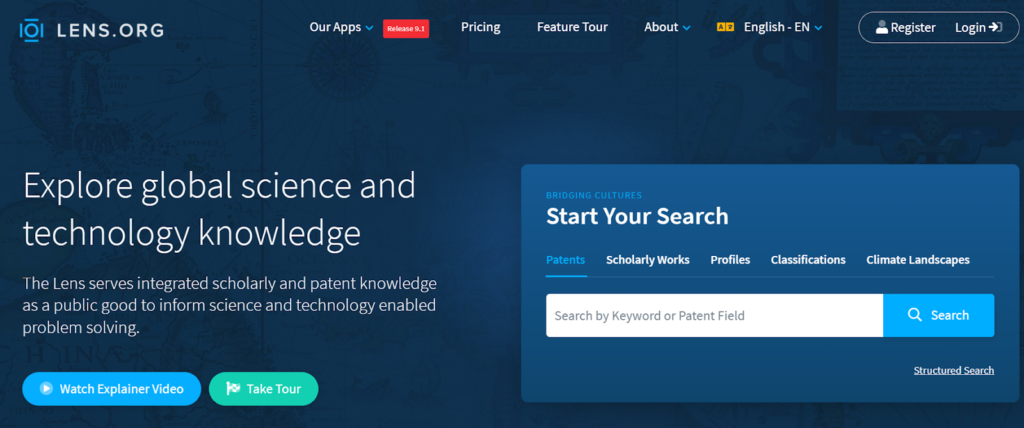
Source: The Lens
Lens.org, is a free, searchable online database of patents and scholarly literature, provided by Cambia, a non-profit organization based in Australia. Launched in 1998, the platform includes over 166.8M patent records from over 106 different jurisdictions and integrates patent data with scholarly and regulatory information to promote open collaboration and informed innovation.
Key Features
- Simple Search: Allows users to quickly search by keyword or patent field, making it easy to find relevant information.
- Advanced Search: Offers detailed filtering options such as flags, institution, institution country/region, author, identifier type, funding, journal, conference name, publication type, publisher, subject matter, open access, query tools, new structured search, and publishing year for precise and comprehensive searches.
- Comprehensive Scholarly Database: Accesses millions of scholarly records, enabling users to explore and analyze academic research linked to patents.
- Citation and Non-Patent Literature Data: Includes citation data and non-patent literature to help users understand the broader impact and context of patents.
#9. DEPATISnet
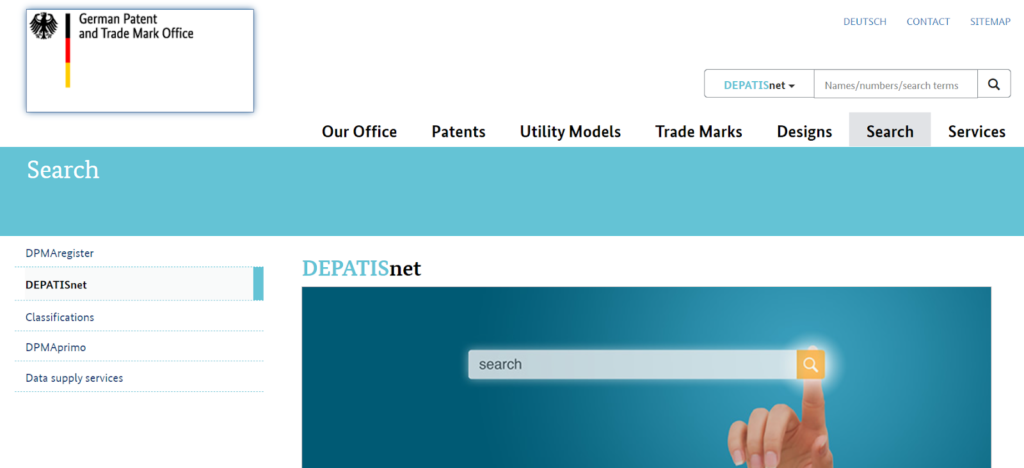
Source: DEPATISnet
DEPATISnet a free online patent search database provided by the German Patent and Trademark Office (DPMA). The database provides access to well over 143 million data records from about 100 countries, making it a very useful resource for state-of-the-art and preliminary freedom-to-operate patent searches.
Key Features
- Search Capabilities: Offers Smart Search for quick searches using publication numbers and inventor names, Basic Search for beginners, Advanced Search for detailed queries across multiple fields, Expert Search for complex queries, and Ikofax Search for specialized IKOFAX syntax users.
- Patent Information Access: Provides comprehensive bibliographic data, full-text access to patent documents, and downloadable original documents in PDF format. Also includes machine translations for Japanese, Chinese, and Korean patents into English.
- Additional Features: Supports International Patent Classification (IPC) searches, customizable result lists, and tree views for visualizing German patent claims. It offers various support options, including hotlines and regional patent information centers, for assistance.
#10. InPASS
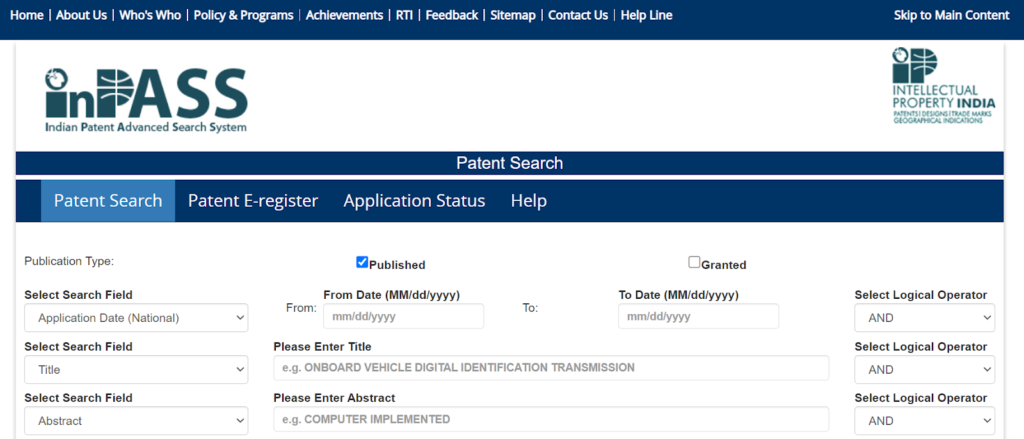
Source: InPASS
The Indian Patent Search System (InPASS), managed by the Intellectual Property Office of India, offers comprehensive and free access to patent documents from India. It provides advanced search functionalities and detailed patent information, making it a valuable resource for global patent research.
Key Features
- Patent Search and Analysis Tools: Offers keyword searches, detailed results, and searches by applicant or inventor names, navigating up to 1000 results per search.
- Accessibility: Provides features like screen readers and magnifiers to ensure accessibility for all users.
- Compliance with Standards: Adheres to XHTML 1.0 Transitional and WCAG 2.0 guidelines for accessibility and compatibility.
- External Website Usability: Promotes inclusivity and equal access to linked external websites.
#11. Japan Patent Office
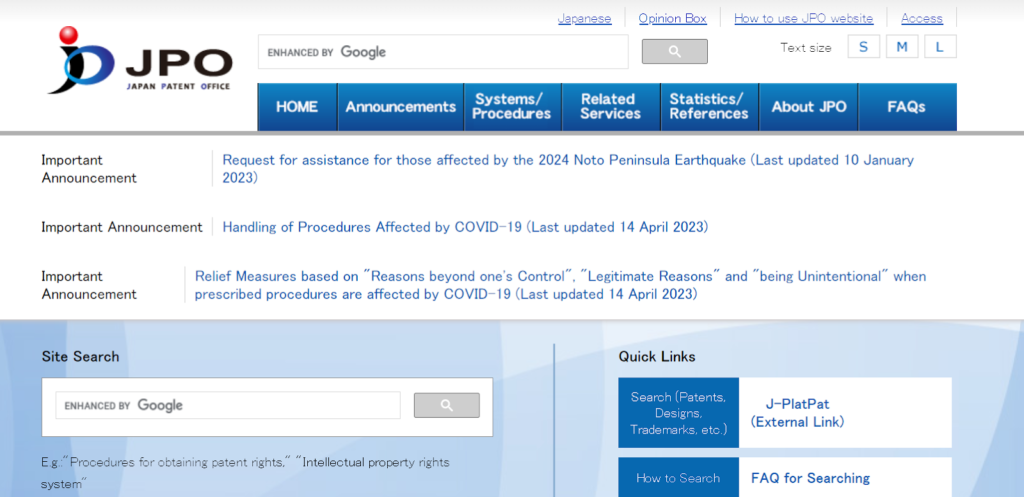
Source: Japan Patent Office (JPO)
Established in 1885, the Japan Patent Office (JPO) ranks third globally in patent applications, following China and the US.
They offer a comprehensive and free online patent database that accesses a vast collection of Japanese patent documents. This free database is essential for conducting thorough patent searches and understanding the landscape of patent information in Japan.
Key Features
- Extensive Patent Coverage: Access to a wide range of Japanese patent documents, utility models, designs, and trademarks, providing detailed information on various inventions and technologies.
- Search Capabilities: Offers simple keyword or patent number searches and detailed searches by classification, date, and other criteria. The One Portal Dossier Search integrates dossier information from multiple foreign patent offices, enabling comprehensive international searches.
- Full-Text Access: Users can access the complete text of patent documents, including claims, descriptions, and bibliographic data, for comprehensive analysis.
- Machine Translations: Provides machine translations of Japanese patents into English and other languages, making it easier for non-Japanese speakers to understand and utilize the information.
Why Global Patent Search Is the Smartest Choice for Patent Search Databases?
Most patent databases are built to show you data. Global Patent Search is built to help you understand it.
While other platforms stop at listing results, GPS takes you one step further i.e. connecting dots, comparing features, and revealing how one invention links to another.
It’s like having a research assistant who not only finds what you asked for but also tells you why it matters.
What really sets GPS apart is how effortless it feels. You don’t need to think like a patent examiner or know search syntax. Just describe your idea in plain English, and the AI instantly brings up the most relevant patents, complete with patent drawings too that make complex data easy to grasp.
The Global Patent Search tool isn’t just about speed, but about depth too. It digs into claim-level details, highlights overlaps, and even identifies emerging trends that might shape the future of your technology.
Whether you’re validating an invention, scouting technology, or planning your next innovation move, GPS gives you answers that are clear, accurate, and actionable.
So if you’ve ever wished patent research could be easier and actually useful, Global Patent Search is exactly what you’ve been waiting for. Try the tool here!

